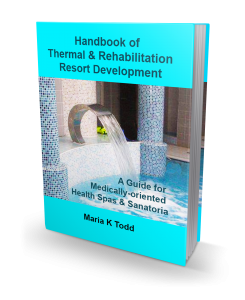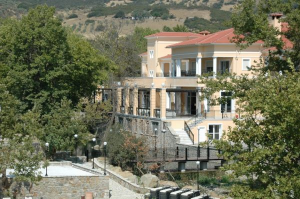Health tourism development in Greece might benefit municipalities, especially those that own and/or operate both developed and undeveloped properties with thermal springs.
These projects would attract and sustain talent and jobs and improve the quality of life in each community. In the USA and abroad, many cities have already turned to strategies to attract tourism investment and other social amenities development.

I have been conducting preliminary research for a big project in Greece, centered on developing a comprehensive national health tourism strategy in that country. Concurrently, I’ve been working continuously on my manuscript for my fourth book on health tourism business development, titled The Handbook of Thermal and Rehabilitation Resort Development: A guide for medical oriented health spas and sanatoria.
One organization I’ve encountered in my research is involved in supporting a number of public private partnerships in the USA. The Health Initiative Coordinating Council (HICCup) is a venture capital and private equity firm that fosters and coordinates citywide health intervention programs in communities throughout the USA. The mission is to gather forces, raise funds and collect extensive data around a citywide set of (self-selected) health interventions including preventive medicine, exercise, nutrition and the like. The goal is to have these programs funded by someone who invests in the expectations of a return, which is the best way for the program to become scalable. According to its founder, Esther Dyson, “Cities are increasingly behaving like companies, becoming intimately involved in the citizens’ quality of life, in an increasingly mobile world (and) competing for customers.”
Hotels that serve to attract and support business and visitors to the region represent tremendous opportunity in a triple-aim benefit to jobs and training opportunities for the community, returns of venture capital to investors, and unique-thermal water and health-oriented resorts available to tourists.
It is in this context that the use of public-private partnerships in hotel development has grown in popularity. Throughout the world, public-private partnerships or PPPs as they are often called, are characterized by the involvement of the public and private sectors in a manner that shares some form of risk, financial or otherwise, and is intended to generate shared rewards, direct revenue from the project or indirect long-term growth in key metrics. To compete, a municipality or destination requires quality hotels, and PPPs are a proven way that a community can respond to this priority.

In Greece as in the USA, modernization, mobility and economic growth are all pushing cities and municipalities to clear the hurdle of their limited resources and invest in the amenities that speak to these priorities. As a part of this, many of developed and undeveloped thermal springs in Greece could be developed to include new investment projects that include quality hotel and accommodations, following in the example of Aldemar Resorts’ award-winning Aldemar Royal Mare Thalasso Resort in Crete, and the Thermae Platystomou Resort and Spa in Makrakomi, which is actually developed on a sprawling campus that includes two of these municipality-owned springs.
A look at the hospitality sector
The hospitality sector has a rich and compelling history of success with the PPP model. In the USA, from 1995 through 2000, the public sector financed nearly $1.5 billion toward 20 separate major convention hotel developments. For example, the Sheraton Overland Park Hotel at the Convention Center in Overland Park, Kansas, where I’ve presented many seminars and workshops over the years is reportedly the first city-owned hotel in the U.S. market. In order to compete as a top-tier hotel with more than 400 rooms and 20,000 square feet of event space connected to more than 250,000 square feet of convention center access, the city partnered with hotel operators, design professionals, a construction guarantee participant and private investors to support the $90 million-plus in development costs. The project placed in the top five for the Midwest market in a recent analysis sourced by Convention, Sports and Leisure International.
In North Carolina, several PPP hotel developments have been opened. One example is the $60-million, 400-room Raleigh Marriott City Center hotel located adjacent to the city’s convention center. The project was supported by the use of private financing, a $20-million grant from the city as well as a public finance discount for necessary parking facilities. A significant portion of the city’s overall $200-million pledge of a hotel occupancy tax base, the Raleigh project falls in line with a number of projects in nearby Charlotte, which also leveraged PPP development structures to support hotel development serving to attract further investment into the region. As a result, Forbes magazine named Raleigh one of the fastest-growing cities in 2014.
Public Private Partnership accomplishments
Aside from the opportunity that PPPs can provide for spurring development, the greater accomplishment is what the development creates: The ability for municipalities and cities to succeed in the competition to attract talent and jobs in the tourism and supporting local and regional value chain.
The speed by which municipal economies are changing and evolving is resulting in the conclusion that greater economic growth is possible. However, the number of growth areas will be limited to communities that continue to evolve. As cities work to provide the amenities necessary to participate in this competition, they are constrained by other infrastructure, constituent demands and the realities of governmental budgets—and the hotel environment is not immune to these circumstances. This is especially true in health tourism development. If a health tourism development is to be considered “complete” then in addition to hospitality on offer, there must be support for health services that can be accessed by tourists visiting the community, whether in the form of dialysis and supporting surgical and laboratory services, the services of a rehabilitation or therapy provider that can provide physical therapy, cardiac rehabilitation, musculoskeletal rehabilitation or other related services, such as diagnostic testing and supportive therapies. To this, there must be adjacent other social amenities nearby to create packages that are interesting to tourists. To read more about my thoughts on investment and health tourism, view my related article AmazingForeign Investment Opportunities for Health Tourism Destination Development from earlier this month. I’d love to read your thoughts and experiences on the topic.
